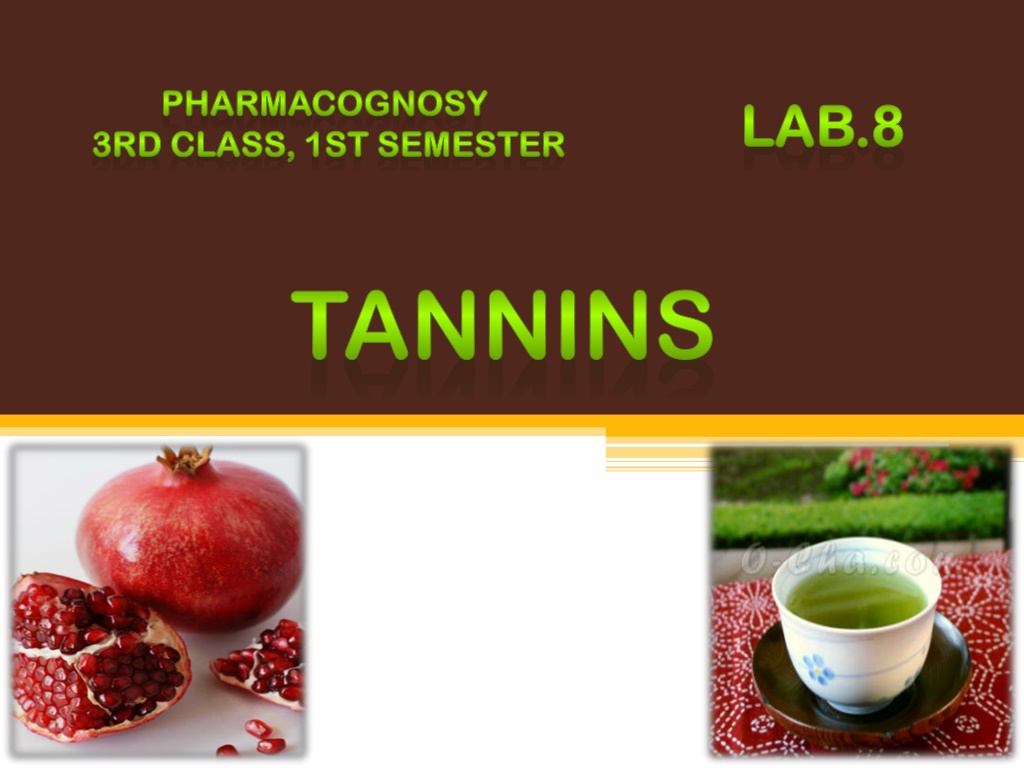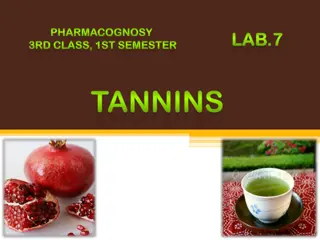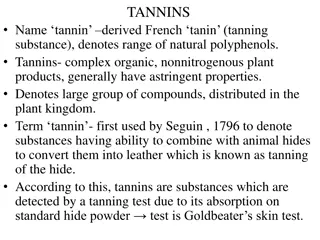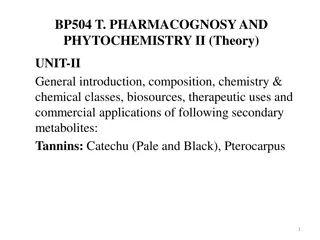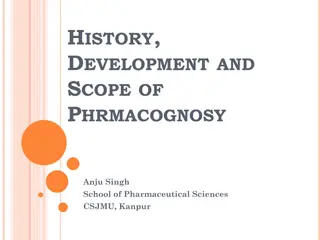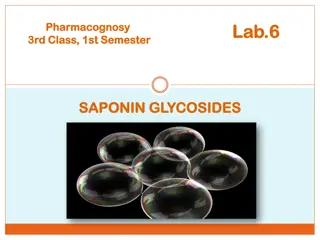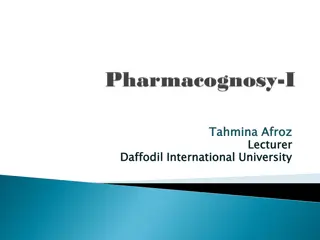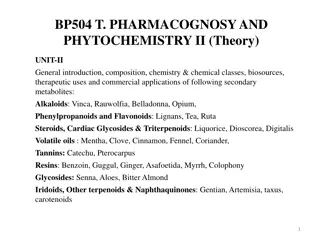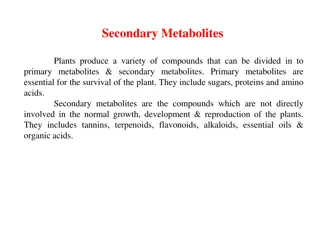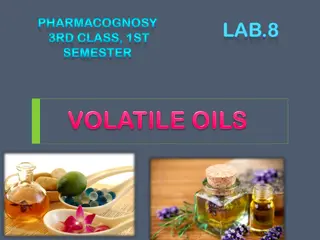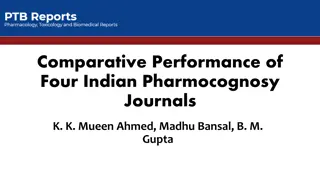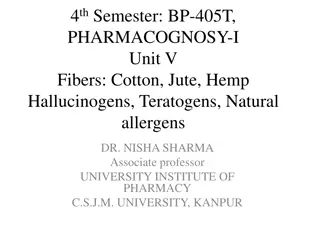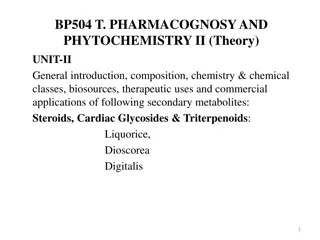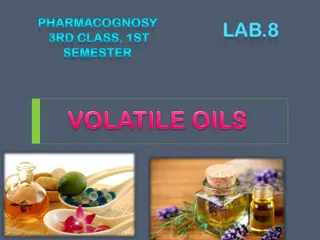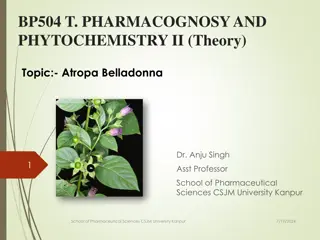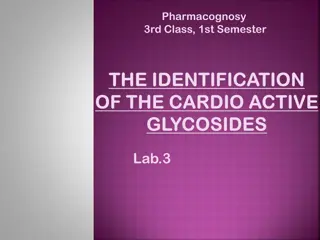Understanding Tannins in Pharmacognosy: Properties, Structure, and Uses
Tannins are phenolic compounds found in plants, known for their complex nature and diverse properties. They are soluble in various solvents, play a role in tanning leather, and have medicinal uses such as treating burns and acting as antioxidants. The interaction between tannins and macromolecules is crucial for their functions. Tannins are classified into two classes based on the phenolic nuclei involved. This summary highlights the importance and versatility of tannins in pharmacognosy.
Uploaded on Sep 22, 2024 | 0 Views
Download Presentation

Please find below an Image/Link to download the presentation.
The content on the website is provided AS IS for your information and personal use only. It may not be sold, licensed, or shared on other websites without obtaining consent from the author. Download presentation by click this link. If you encounter any issues during the download, it is possible that the publisher has removed the file from their server.
E N D
Presentation Transcript
PHARMACOGNOSY PHARMACOGNOSY 3RD CLASS, 1ST SEMESTER 3RD CLASS, 1ST SEMESTER LAB.8 LAB.8 TANNINS
Introduction Tannins are phenolic compounds and comprise of a large group of complex substances that are widely distributed in the plant kingdom. Chemically tannins are complex substances that are difficult to separate because they do not crystallized. Properties a) Pale yellow to light brown-red amorphous substances widely distributed in plants. b) Water-soluble and also soluble in dilute alkali, alcohol, glycerol and acetone but slightly soluble in other organic solvents. c) Tannins can precipitate alkaloids, gelatine, and other proteins. d) Tannins give tea astringency, color, and flavor. e) They are isolated from oak bark and sumac. f) Their solutions are acid and have an astringent taste.
Tannins Uses a) In the treatment of burns, the protein of the exposed tissue is precipitated and forms a mildly antiseptic, protective coat under which the regeneration of new tissue may take place. b) Antidote treatment of the alkaloid poisoning. c) Antiviral, antibacterial and antiparasitic effects. d) Antioxidant for scavenging free radicals. e) Used mainly in tanning leather, dyeing fabric, and making ink.
Tanning : is the process of treating skins of animals to produce leather, which is more durable and less susceptible to decomposition and that is by formation of bonds between the collagen fibres of the hide (imparts resistance to water, heat and abrasion). This capability of tannins to combine with macromolecules explains why : a) They precipitate cellulose, pectin and proteins. b) Explains their characteristic astringency and tartness by precipitating the glycoproteins which is contained in saliva and tannins make the saliva lose its lubricating power.
Cont The combination between tannins and macromolecules is established by : a) Hydrophobic interactions b) Hydrogen bonds between the phenolic groups of tannins and the proteins or other polymers. c) The covalent bonds established after oxidation of the phenols to quinones. The condition necessary for the formation of these linkages is the tannin s molecular weight must fall within a well defined range. a) If it is too high, the molecule cannot insert itself into the interfibrillar spaces of the macromolecule. b) If it is too low, the molecule can insert itself but cannot form enough bonds to stabilize the combination.
Tannins are divided to two classes according to the identity of the phenolic nuclei involved: 1) HYDROLYSABLE TANNINS (Esters of a sugar and phenolic acid molecules) A. Gallotannins ex: Galls B. Ellagitannins ex: Pomegranate rind Hydrolysable tannins: are hydrolyzed by weak acids or weak bases or enzymes such as tannase to produce carbohydrate and phenolic acids and the phenolic acids are united by ester linkages to a central sugar (glucose) molecule and therefore the hydrolysable tannins are esters of a sugar and phenolic acid molecules. The phenolic acid is: A. In the case of Gallotannins Gallic acid B. In the case of Ellagitannins Hexahydroxydiphenic acid (HHDP) and its oxidized derivatives (Dehydrohexahydroxydiphenic acid).
2) NONHYDROLYSABLE TANNINS OR CONDENSED TANNINS Are polymers of 2 to 50 (or more) flavonoids units that are joined by carbon-carbon bonds, which are not susceptible to being cleaved by hydrolysis. They are not readily hydrolysed to simpler molecules and they do not contain a sugar moiety (unlike hydrolysable tannins). On treatment with acids or enzymes, condensed tannins are converted into red insoluble compounds known as phlobaphenes. Phlobaphenes give the characteristic red colour to many drugs such as red cinchona bark. These tannins are therefore sometimes called catechol tannins (as they yield catechol).
Test on Tannins Test on Tannins Catechol Tannins (Condensed Tannins) Hamamelis leaf (witch Hamamelis leaf (witch- -hazel leaf) Botanical name Hamamelis virginiana Family Hamamelidaceae hazel leaf) Medicinal uses Witch Hazel contains tannins, flavonoids compounds, volatile oil and astringent, antioxidant, antiseptic and antiviral properties. It is prescribed for diarrhea, dysentery, mouth ulcers, skin inflammation, sore throat. It also acts as a skin tonic, a cure for eye inflammation and hemorrhoids.
A. A. Examine Examine The powder drug microscopically for the trichomes and notice the type of stellate, the form branched stellate trichomes consisting of 4- 12 unicellular branches united by their bases.
B. B. Chemical tests Chemical tests Aim Aim To identify the catechol tannins. Procedure Procedure 1) Boil 5gm of hamamelis leaf, coarsely powdered with 50 ml of water. 2) Cool and filter. 3) To 5ml portions add the following reagents and notice the results:- a) b) c) d) e) f) Few drops solution of ferric chloride. 1ml solution of lead sub acetate. 1ml solution of potassium dichromate. 2ml solution of gelatin. 2ml solution of quinine dihydrochloride. 0.5ml of sodium acid phosphate, warm, cool and filter. To the filtrate add sodium of phenazone. Bromine water. 5ml Mitchell's reagent (5ml of a 0.2%solution of iron and ammonium citrate) and add 1gm sodium acetate. Boil, cool and filter. g) h) Notice the colors and precipitates obtained. Results Results
Results Greenish to black color Ferric chloride Reddish brown bulky precipitate. Lead sub acetate Dark color Potassium dichromate White precipitation of gelatin Gelatin Bulky, colored precipitate Sodium acid phosphate Phenazone Bromine water No change in color water soluble iron tannin complex Mitchell's reagent
Pyrogallol Tannins (Hydrolysable Tannins) Galls, Nutgall Botanical name Quercus infectoria Family fagaceae The bark is considered astringent, and used for treating nose bleeding, certain chronic skin diseases like eczema. Seeds are used as a food flavoring agent, usually dry seeds are powdered and added into breads and cereals. The galls are rich in tannins and also have anti-viral and anti-septic. They are used in treating pharyngitis, diarrhea, dysentery, hemorrhoids. Medicinal uses Medicinal uses
A. A. EXAMINE EXAMINE The powdered drug microscopically and notice the following: Fairly numerous sclernchymatous cell Lignin bodies The presence of only a few small vessels. Few starch gains Thick wall pitted parenchyma with both cluster and crystals of calcium oxalate.
B. B. CHEMICAL TEST CHEMICAL TEST Aim Aim To identify the pyrogallol tannins Procedure Procedure Prepare 0.01% suspension of powdered nutgall in water and is treated with:- a) A saturated solution of potassium dichromate plus a trace of acetic acid b) A 1% solution of sodium carbonate c) A 5%ferric sulphate solution d) A 1% ferric acetate solution e) Shake 0.1 gm powdered nutgall with 1ml of water, micro filter one drop into evaporating dish. Add one drop of a 5%ferric chloride solution f) repeat the test e with bromine water Results Results Record the colors obtained
THANK YOU THANK YOU
